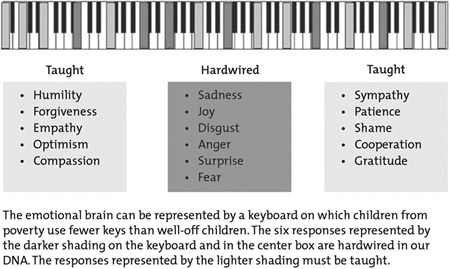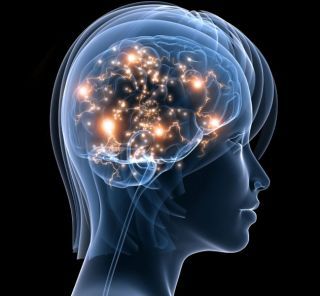Karla McAdam’s Updates
Poverty and Brain Development as Seen from One Educator/Author’s Perspective
What do we know about the affects of poverty on brain development and learning in some of our most needy children? Author Eric Jensen has devoted a career to examining research that can help shed light on this question. Jensen (2009), in his book Teaching with Poverty in Mind: What Being Poor Does to Kids’ Brains and What Schools Can Do About It, discusses how brain research has made a paradigm shift from believing that brains remain unchanged from birth, to the new understanding that brains can and do change every day. Jensen’s (2009) literature points out four major risk factors for children of poverty to include: emotional and social challenges; acute and chronic stressors; cognitive stimulation or lags; and health and safety issues.
Emotional and Social Challenges
Jensen (2009) talks about six hardwired emotions that are present and available for all children at birth – sadness, joy, disgust, anger, surprise, and fear. Now think about all of the other human emotions out there and take a look at the image below.
Source: Jensen, E. (2009). Teaching with poverty in mind: What being poor does to kids’ brains and what schools can do about it. Alexandria, VA: Association for Supervision and Curriculum Development.
There are ten additional emotions that must be explicitly taught. Often, it has been found that many of the taught emotions are missing from children in poverty, yet in our current education systems we expect children to arrive to school with all emotions understood and under control. This is where classroom discipline and academic problems begin to emerge when we have a mismatch between school and/or teacher expectation and students’ knowledge and understanding of key emotions – like cooperation, empathy, patience, and compassion to name a few.
So what can we do to support the emotional and social challenges facing children in poverty? Jensen (2009) recommends we embody respect to support emotional development, embed social skills into the classroom, and be inclusive through word choice, acknowledgements, and celebrations. Listen to Jensen in the video below to gain insight into statistics and scientific peer-reviewed studies around poverty and its affect on the brain:
Acute and Chronic Stressors
Acute and chronic stressors often experienced by children living in poverty influence and directly affect brain development. When we are stressed, our bodies naturally produce cortisol as a means to combat the stressors before us. This is commonly known as the fight or flight reaction. Chronic stress not only produces a constant flow of cortisol, but has been shown to decrease neural pathways and activity, permanently changing the brain and limiting learning and memory capabilities.
So what can we do to combat acute and chronic stressors? Jensen (2009) suggests we recognize and acknowledge the signs in children and seek to be positive over punitive. He also recommends altering the environment in the classroom to lessen potential additional stressors and provide structures that will promote physical activity. Lastly, Jensen encourages educators to empower students by supporting them with conflict resolution skills, strategies to deal with anger management, goal setting opportunities, and interactions with peers to promote social skills.
Cognitive Stimulation or Lags
Modern technology and advances in research have afforded opportunities for greater, in-depth studies in the area of cognitive neuroscience. One area of high interest has been the linkage between levels of language acquisition and socioeconomic status. Studies by Hart and Risley (1995) have revealed that preschool children, by the age of 3, who reside with professional parents, acquire vocabulary at twice the rate of preschoolers who live in poverty. According to Noble, Wolmetz, Ochs, Farah & McCandliss, (2006),
“Evidence suggests that poverty adversely alters the trajectory of the developing reading brain” (as cited in Jensen, 2009, p. 37).
So what can we do to support cognitive stimulation and lags? Educators can build core skills to improve attention, promote problem-solving skills, and increase self-esteem and abilities to persevere and be resilient. Assessments are a must to accurately pinpoint the most fundamental skills for individualized interventions. And last, but not least, providing hope and scaffolding support for children so they can be successful, both academically and emotionally.
Health and Safety Issues
Children born into poverty are more likely to be premature, have low birth weight and disabilities. They are far less likely to get the medical care they need to combat illnesses and injuries, as well as poor nutrition. These factors, in turn, lead to higher rates of school absences, tardiness, illness during school days, and undiagnosed health problems.
So what can educators do to support health and safety issues for children in poverty? Jenson (2009) suggests schools provide and increase and wide-range of health-related services, make efforts to create an environment that reduces stress, cognitively challenge students daily, and build relationships between faculty and peers.
Further Explorations:
Neuroscience and the Emerging Mind: A Conversation with the Dalai Lama
Check out this book: Poverty and brain development during childhood: An approach from cognitive psychology and neuroscience.
References:
Hart, B., & Risley, T. (1995). Meaningful differences in the everyday experiences of young American children. Baltimore: Brookes Publishing.
Jensen, E. (2009). Teaching with poverty in mind: What being poor does to kids’ brains and what schools can do about it. Alexandria, VA: Association for Supervision and Curriculum Development.
Noble, K. G., Wolmetz, M. E., Ochs, L. G., Farah, M. J., & McCandliss, B. D. (2006, November). Brain-behavior relationships in reading acquisition are modulated by socioeconomic factors. Developmental Science, 9(6), 642-654.






